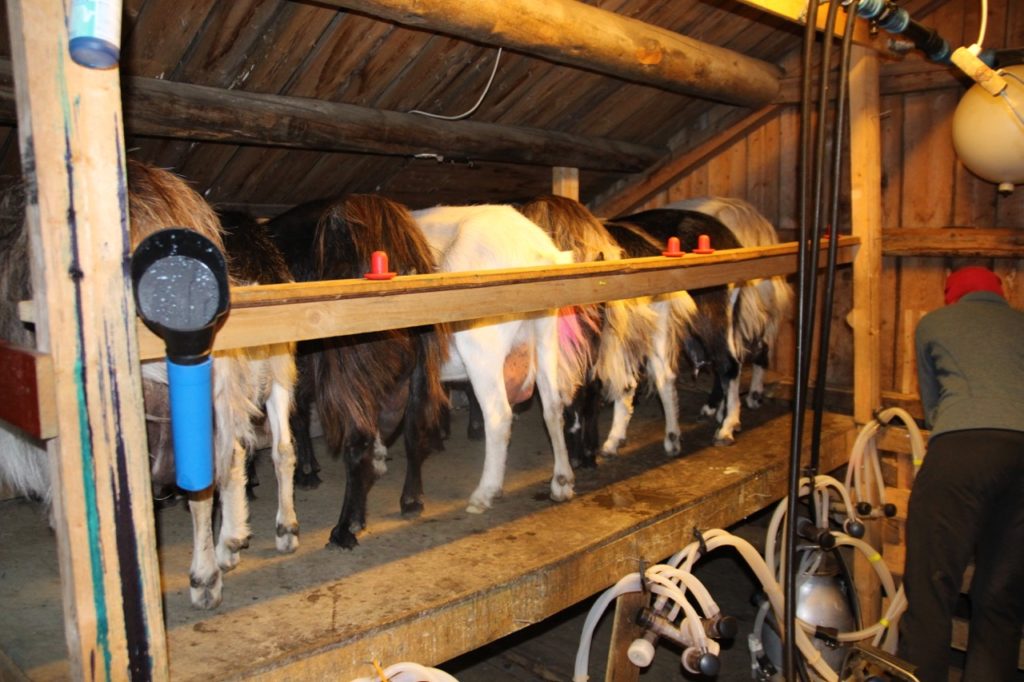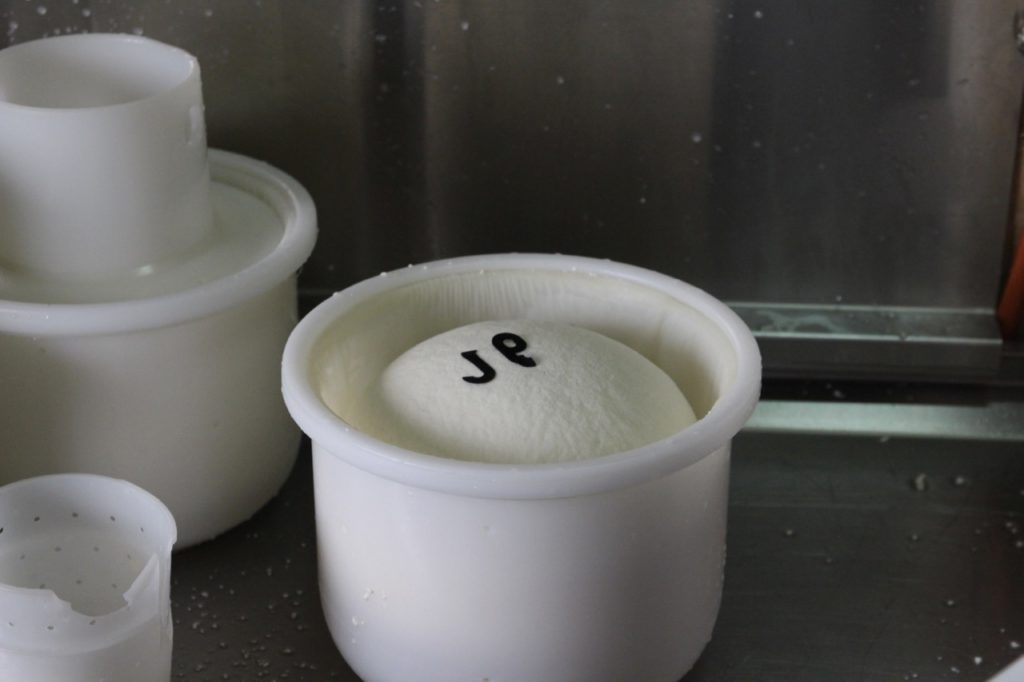Det var en høyst upersonlig invitasjon, men jeg responderte ganske spontant da Olestølen mikroysteri spurte på Facebook om det var noen som hadde lyst å komme til seters for å yste. Det hadde jeg nemlig. Ikke så ofte jeg får muligheten til å yste, prøver å være freidig nok til å invitere meg selv, og lykkes av og til med det. Har ystet noen ganger, så jeg begynner å få inn rutinene og føler ikke at jeg bare står i veien. Dette med rutiner er for øvrig ganske forskjellig fra ysteri til ysteri, så det gjelder ha litt intuisjon på hva som kommer til å skje. Men, jeg fikk altså hyggelig tilbakemelding om at jeg var hjertelig velkommen til fjells. Tre og en halv time fra Oslo. Melking fra kl 6.30, og deretter umiddelbart ysting, så jeg takket ja til å komme kvelden før.
Olestølen mikroysteri ligger i Valdres
På vei oppover innså jeg at det var veldig lenge siden jeg hadde kjørt til Valdres. For det første opplevdes strekket fra Hallingby til Nes i Ådal usedvanlig traurig og langt, samt at det gledeligvis er en del veiarbeid slik at vi blir kvitt de svingete bakkene opp fra Bagn. Fra Fagernes til Olestølen tar det akkurat 50 minutter, retning Beitostølen og du tar av inn på Olevegen litt etter Skammestein. Bomvei for øvrig; ha med kontanter, for Vipps er ikke nødvendigvis så utbredt, tydeligvis. Åtte kilometer god vei.
Natta lå der.. og deretter tidlig morgen
Kom fram akkurat i tide før det ble bekmørkt. Natta er ganske svart når det ikke er noen form for lys i området, så det var bare å rulle ut soveposen og gå til køys.
Ysting – en fantastisk kunst
Melken ventet, så det var ikke noe å drøye frokosten etter. Ysteriet er forøvrig det absolutt minste ysteri jeg noen gang har vært i. På hjul. De bruker det på gården før og etter stølssesongen, som for øvrig er fra rundt midten av juni til midten av september.
Jeg vet ikke om du har tenkt over det, men for melk av geit og ku, så går det med rundt regnet ti liter for å lage én kilo ost. Siden egenvekten for melk er lik for vann, i hvert fall lik nok for dette formålet, så brukes altså ti kilo melk for å tilvirke en kilo ost. De resterende ni kiloene er myse som man kan koke brunost på, fôre grisene med, bruke til brødbakst, selge til en eller annen produsent som lager mysepulver av det så kroppsbyggerne får sitt, sikkert flere andre formål også, eller helle det ut. Denne dagen gikk det til grisefôr, mens andre dager blir mysen blandet med fløte og kokt til brunost.
Kjede dere??
Nå skal jeg ikke kjede dere med kutting av koagelet, som det heter, men vi kuttet fra en hel veldig flott og fast “masse” og ned til riskornstørrelse. For hånd selvsagt. Siste halvtimen betød det for min del å røre i ostemassen og mysen med en diger storkjøkkenvisp, så all mulig ostemasse ble finkuttet og vi var sikre på at ingenting hadde klumpet seg. Det var slitsomt, men moro. Mest slitsomt for ryggen, siden ystekaret var litt lavt for meg. I tillegg måtte vi øse ut mysen, det var vel en rundt 125 liter, tenker jeg. Med et litermål. Litt kronglete for meg å holde tellingen, når budeia er litt pedagogisk og forklarer ysteprosess og annet forefallende samtidig. Det med tellingen var litt viktig siden mysen gikk i en 30-liters tank på utsiden. Måtte jo bytte tank noen ganger. Spøk til side. Det var veldig hyggelig og lærerikt, fordi Kathrin Aslaksby delte så utrolig villig av sin kunnskap. Og de forskjellige prosessene under ystingen og veien fram til ferdig ost er alt annet enn kjedelig. Slitsomt innimellom, ja, men kjedelig? Aldri verden.
Over i former
Deretter var det jo “bare” å ta ostemassen over i former. Presse. La det renne av litt mer, ta ostene ut av formene og snu dem. De skal tilbake i formene. Det ble min jobb siden det kom besøkende som ville handle ost. Hvis du ikke er dreven på å snu ost mens den fremdeles er i formen, så skal du vite at det faktisk er litt vanskelig. Det vanskelige består i å få den riktig ned i formen igjen.
Denne dagen ystet vi Kvit Ole, alternativt Vis Ole, det har med modningstid å gjøre. En halvfast hvit geitost. I små pauser innimellom ystingen, så hadde jeg snudd alle Mugnetind som sto til modning, det er enkelt, samt snudd alle de store ostene som sto til modning i selet. Det innebar også å stryke ned all hårete mugg som hadde vokst på osten, og skal gjøre det. Det siste var litt mer kronglete for ryggen siden jeg måtte stå litt krokbøyd.
Til slutt
Så da alt dette var gjort, hva sto igjen da? Vaske. Vaske. Så fikk jeg gleden av å fôre grisene til slutt. Myse og gammelt brød. Det ville også en av gjessene ha. Prøvde seg på å bite meg i skoen, men innså vel at det var en tapt kamp, bedre å fokusere på å stjele litt brød fra grisene mens det ennå var noe igjen. Så lunsj med smaking av oster. Hyggelig og godt.
Anbefaler en tur
Olestølen er et fantastisk sted å dra til. De har åpen støl hele sommeren, frem til midten av august, dog ikke hver dag. Du kan komme dit på helgearrangement; være med på å koke brunost, kløve opp hestene og dra på tur innover fjellet og mye annet. Anbefales, og det er ikke så galt å ta en tur til Valdres heller. Fint der.
Hva tilvirker de på Olestølen?
I tillegg til Kvit Ole som vi ystet, lages en chèvre-type som heter Mugnetind. Navnet er etter et fjell i området. Brunost kokes innimellom i jerngryte over åpen ild, ute. Stor stas. De kinner også et fantastisk geitesmør. I tillegg yoghurt og surmelk.
Veldig gode produkter som alle er tilvirket av økologisk geitemelk. Kan være litt vanskelig å få tak i, så det tryggeste er å ta turen inn til stølen om du er på de trakter.
Se forøvrig video her om hva jeg tenker om Mugnetind.
Kvit Ole og Vis Ole, som er den lagrede varianten, er med på grunnkurset i september. Påmelding her.
